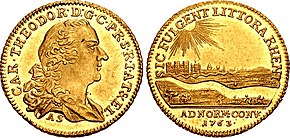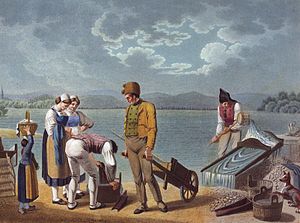River gold ducats

River gold ducats are coins that were minted from the gold of the rivers Danube , Rhine , Eder , Isar , Inn and Schwarza . They usually show the origin of the gold through pictures and writing. The gold panning for ducats was operated from the 17th to 19th centuries. They provided only small amounts of gold that were minted into coins. River gold ducats are therefore rare and particularly valuable.
Coin history
In Small Contributions to… Coin Science by Johann Jakob Spieß (1768) the conditions for panning for gold on the Rhine in the Electorate of Palatinate are named. Accordingly, gold panning was permitted
"Against payment of a small recognition in temporal, but with the condition that the same [the gold washers] should not sell the collecting gold anywhere but to their sovereign [...]."
Panning for gold happened there, according to JJ Spieß, “where the Rhine stream extends a little wider in that area”. The river gold was washed from the black sand
This means that by adding mercury ( amalgamation ) the gold was removed or cleaned in order to melt it. The low yield did not allow gold panning to be mechanized . The result was gold with a fineness of eighteen to nineteen carats with two to three carats silver mixed.
There are river gold ducats from the Palatinate , Bavaria , Baden , Mainz and Hesse . They were mainly minted in Bavaria from 1756 to 1863 and Baden from 1767 to 1854. The first ducat marked as such is a Palatine half ducat from 1674. It came from Karl Ludwig (1648–1680), Elector of the Palatinate ( Palatinate-Simmern line ). The last German coin from River Gold is a Bavarian ducats of 1863. Kurpfälzische Rheingold ducats, with the designs for the sunlit Cityscape Mannheim with the Rhine (see above), there are already 1742 under Karl Philipp (1716-1742).
The origin of the gold is usually stamped in Latin . Examples are:
- EX AURO RHENI - from the gold of the Rhine (Bavaria)
- EX SABVLIS RHENI - from the sand of the Rhine (Baden)
- SIC FULGENT LITTORA RHENI - this is how the banks of the Rhine shine (Kurpfalz)
- AURUM / RHENI - Rheingold (Mainz)
- EX AURO DANVBII - from the gold of the Danube (Bavaria)
- EX AURO ISARÆ– from the gold of the Isar (Bavaria)
- EX AURO OENI - from the gold of the Inn (Bavaria)
- SIC FVLG (ent) LITORA ADRANAE AURI FLVAE - this is how the banks of the gold-bearing Eder (Hessen-Kassel) shine
The specially marked rarities mostly show cityscapes with the respective river on the back as well as river gods with a spring urn from which water flows. The Rhine gold ducats of the Grand Duchy of Baden can only be recognized by the inscription EIN DUCAT AUS RHEINGOLD on the reverse side from the year of minting 1832 (edition 6631 pieces) to the last minting in 1854 (edition 1820 pieces). In the case of the river gold ducats of the Kingdom of Bavaria , the minting numbers with other ducats are only given together.
Coin description of a Rhine gold ducat
- See the depicted river gold ducat from 1763
What is special about the coin image of the Rheingold dukaten of the Electoral Palatinate is that it shows gold washers at work on the Rhine. The river gold ducat from 1763 comes from the Mannheim mint . The rough weight is 3.49 grams, the diameter 21.5 millimeters and the fineness 23 carats 8 Grän (= 986/1000).
front
The obverse shows the draped bust of Elector Karl Theodors von der Pfalz , underneath the letters A S. That is the signature and at the same time the mint master's mark of the Electoral Palatinate court medalist , coin die cutter and mint master Anton Schäffer in one person.
- Transcription: CAR (olus) • THEODOR (us) • D (ei): G (ratia) • C (omes) • P (alatinus) • R (heni) • S (acri) • R (omani) • I (mperii ) • A (rchi) • T (ruchsess) & EL (ector)
- Translation: Karl Theodor by the grace of God, Count Palatine of the Rhine of the Holy Roman Empire Archdean and Elector.
back
On the back, the electoral residence city of Mannheim with the palace is illuminated by the sun . In the foreground on the left bank of the Rhine are gold washers. In the section, AD NORM (am) • CONV (entionis) • / 1763 • (= in accordance with the agreement) referred to the coinage convention .
- Inscription: SIC FULGENT LITTORA RHENI
- Translation: So shine the banks of the Rhine.
Note: According to Johann Jakob Spieß, the gold washers shown on the back of the ducat and busy with their work are on the left bank of the Rhine, "which represents the area of Seltz and Hagenbach ".
See also
- Reichsgulden to 21 Groschen (1584) , an extraordinary gold coin
literature
- Johann Jakob Spieß: Small contributions to… coin science , Anspach 1768, p. 56; 57; 72; 87; 88
- Johann Friedrich Joachim: The third part of the newly opened coin cabinet, therein remarkable gold and silver coins that have not yet been reported anywhere ... , Nuremberg 1770, pp. 253/254
- Heinz Fengler, Gerd Gierow, Willy Unger: transpress-Lexikon Numismatics. transpress Verlag, Berlin 1976, p. 95
- Friedrich von Schrötter , N. Bauer, K. Regling, A. Suhle, R. Vasmer , J. Wilcke: Dictionary der Münzkunde , Berlin 1970 (reprint of the original edition), p. 199
- Helmut Kahnt: The large lexicon of coins from A to Z. H. Gietl Verlag, Regenstauf 2005
- Paul Arnold, Harald Küthmann, Dirk Steinhilber: Large German coin catalog from 1800 to today , Augsburg 1997
- Gerhard Schön: German coin catalog 18th century , Munich 1984
- N. Douglas Nicol, Colin R. Bruce: Standard Catalog of German Coins. 1601 to Present. Krause Publications, Iola (Wisconsin) 1998
- Josef Rothmaier: Oberhausen-Rheinhausen - a local history reader , municipality of Oberhausen-Rheinhausen 2016
Individual evidence
- ↑ Heinz Fengler, ...: transpress-Lexikon Numismatik (1976), p. 95
- ↑ Johann Jakob Spieß: Small contributions to… coin science (1768), p. 72: Conditions
- ^ Johann Jakob Spieß: Small contributions to… coin science (1768), pp. 68/69
- ^ Fritz Rudolf Künker GmbH & Co. KG - Auction 315, No. 8222
- ↑ Johann Jakob Spieß: Small contributions to… coin science (1768), p. 69: Feingehalt
- ↑ Heinz Fengler,…: transpress-Lexikon numismatics. (1976): Embossing period p. 95
- ^ N. Douglas Nicol, Colin R. Bruce: Standard Catalog of German Coins. 1601 to Present , p. 613: ½ ducat 1674, Karl Ludwig von Pfalz-Simmern
- ^ Josef Rothmaier: Oberhausen-Rheinhausen - a local history reading book (2016), p. 131: EX. A. RH. 1674
- ↑ Münzkabinett Berlin : Mint from the Electoral Palatinate, Bavaria, Baden, Mainz and Hesse (Isar gold ducats from 1798 with river god).
- ^ Gerhard Schön: German coin catalog 18th century (1984): p. 498, No. 105, undated (1742)
- ^ Johann Jakob Spieß: Small contributions to… coin science (1768) p. 57; 86-88
- ^ Gerhard Schön: German coin catalog 18th century , (1984)
- ↑ Paul Arnold, ...: Large German coin catalog from 1800 to today (1997)
- ^ Paul Arnold,…: Large German coin catalog from 1800 to today (1997), pp. 30–35
- ^ Paul Arnold, ...: Large German coin catalog from 1800 to today (1997), pp. 50–65
- ^ Johann Jakob Spieß: Small contributions to… coin science (1768) p. 81
- ^ Johann Friedrich Joachim: The newly opened coin cabinet third part, ... , (1770), p. 253
- ^ Johann Jakob Spieß: Small contributions to… coin science (1768), p. 56, but here Thesaurarius instead of Truchsess
- ^ Johann Friedrich Joachim: The newly opened coin cabinet, third part, ... , (1770), p. 254
- ^ Johann Jakob Spieß: Small contributions to… coin science (1768), p. 57: area of Seltz and Hagenbach
